Top 10 Most Beautiful Historical Sites in Greece
Greece was influential in ancient times and is sometimes referred to as the "cradle of civilisation." With its area having been battled over numerous times ... read more...over the course of its 40,000-year history, there are now a variety of remarkable sites that bear witness to the country's wealth of ideas and central role as an ancient force. Let’s discover the most beautiful historical sites in Greece.
-
The Acropolis is one of the most well-known historic locations in the world, and it serves as an inspiring reminder of Ancient Greek civilization's achievements. The Parthenon, the Erechtheion, the Propylaia, and the temple of Athena Nike are among the buildings and monuments on the Acropolis, which stands tall above the Greek city of Athens. The Acropolis was designated a UNESCO World Heritage Site in 1987.
The Acropolis, one of the most beautiful historical sites in Greece, is a very popular historic monument that attracts a large number of visitors each year. The neighboring Acropolis Museum, which opened recently, houses an outstanding collection of exhibitions and artifacts from the Acropolis itself.
After Lord Elgin took the marbles from the Acropolis in the early 19th century, most of the art that graced the Parthenon is now on display at the British Museum. At the Acropolis Museum, empty areas have been purposefully left to demonstrate Greece's immediate ability to host and care for the Elgin Marbles if they are returned to Greece from the British Museum.
Location: Athens
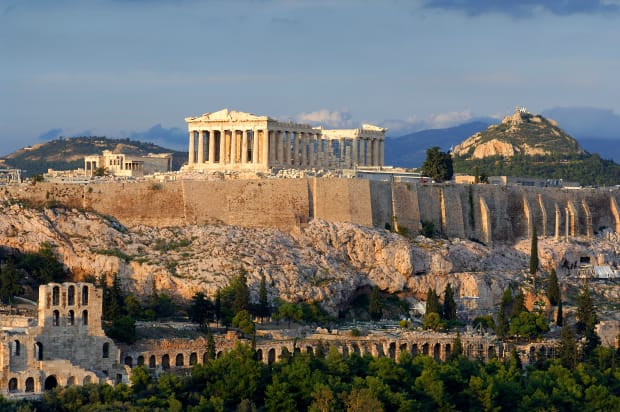
Source: history.com Source: Discovery UK -
Santorini's Akrotiri is a magnificently preserved prehistoric monument known for its stunning frescos and Minoan connections. Visitors can now wander among the site, which is one of our Top 10 tourist attractions in Greece, which is covered by a bioclimatic roof. In truth, Akrotiri was inhabited as early as the 4th millennium BC – some claim even earlier – as a small fishing and farming community during the late Neolithic period. In the next century, during the Bronze Age, it would thrive and expand into a larger settlement of up to 20 hectares.
The beautiful remains of Akrotiri today provide witness to the sophisticated urban civilization that previously thrived there. The structures are not just multi-story, but many of them have vibrant frescoes depicting various themes. Because of its outstanding state of preservation, it has been dubbed the "Minoan Pompeii" after another renowned volcanically preserved site.
Akrotiri, however, has another claim to fame. Akrotiri was thought to be linked to Knossos and to have been a Minoan site. Some, on the other hand, have claimed that it was the lost city of Atlantis.
Location: Santorini
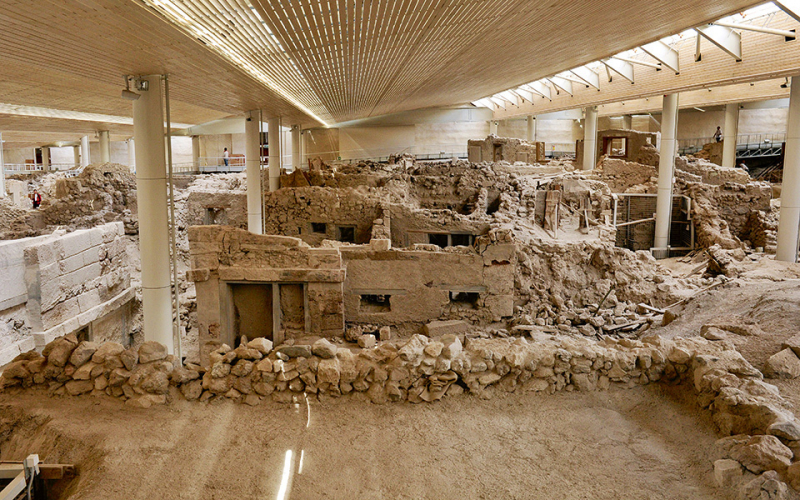
Source: Greece Is Source: Jeff B -
Mystras, also known as "Morea," is a hill overlooking Sparta. William II of Villehardouin, a prince of Achaea who had participated in the Fourth Crusade, chose to erect a castle there as a defense against the Byzantines in 1248-1249. Following his defeat at the hands of Byzantine Emperor Michael VIII Palaeologus, William was taken prisoner shortly after the castle was built. Spartan inhabitants used the castle at Mystras as a shelter beginning in 1262, but soon stayed there and began developing a city around it.
Many churches, palaces, residences, and other structures, including its famous fortification, were considered to be some of the outstanding architectural treasures of their time, known as the "wonders of Morea," during its time as a thriving metropolis.
Today, Mystras is home to a number of Byzantine churches and a monastery, as well as remnants such as the castle, roadways, and fortress walls, all set in a breathtaking environment. The site's entrance is especially beautifully preserved. A neighboring Mystras Museum houses artifacts from the site.
Location: Peloponnese
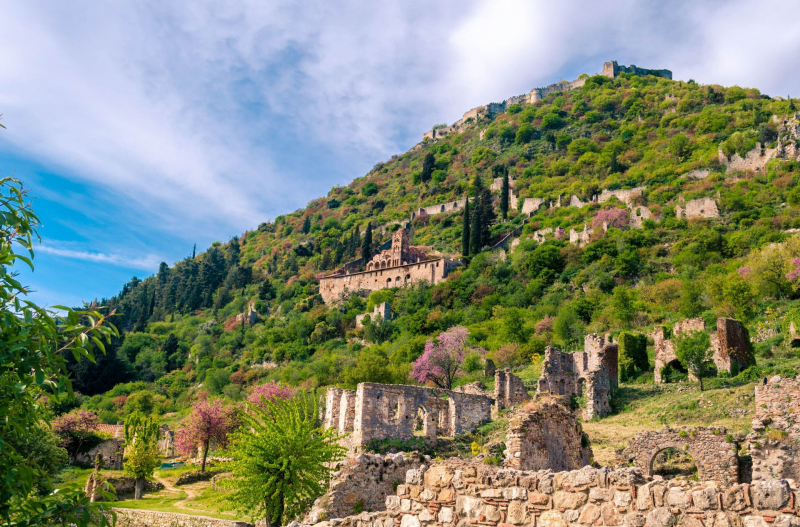
Source: Greeka Source: lambros malamas -
In the Athenian Agora, the Temple of Hephaestus is a magnificent ancient Greek temple. It has been called Greece's best preserved ancient Greek temple. The architrave and the frieze are located above the columns, with the latter composed of triglyphs interwoven with metopes. The Heracles Labors are depicted on the ten metopes of the Temple of Hephaestus' eastern side. The ruins of the triangular pediments can be found above the triglyphs and metopes at each end of the temple. Originally, these would have been filled with huge statues.
Because it was previously thought that the bones of the legendary Athenian king Theseus were buried here, the Temple of Hephaestus is also known as the 'Theseum.' The Temple of Hephaestus was eventually merged into the Church of Agios Georgios, which explains why it is in such good condition.
One of the most beautiful historical sites in Greece, the Temple of Hephaestus is now Greece's best-preserved ancient Greek temple. It is a must-see site for anybody visiting Athens, as it is located among the ruins of the lovely Athenian agora. The remnants of the Temple can be seen among the trees of the Agora if you look north from the top of the Acropolis.
Location: Athens
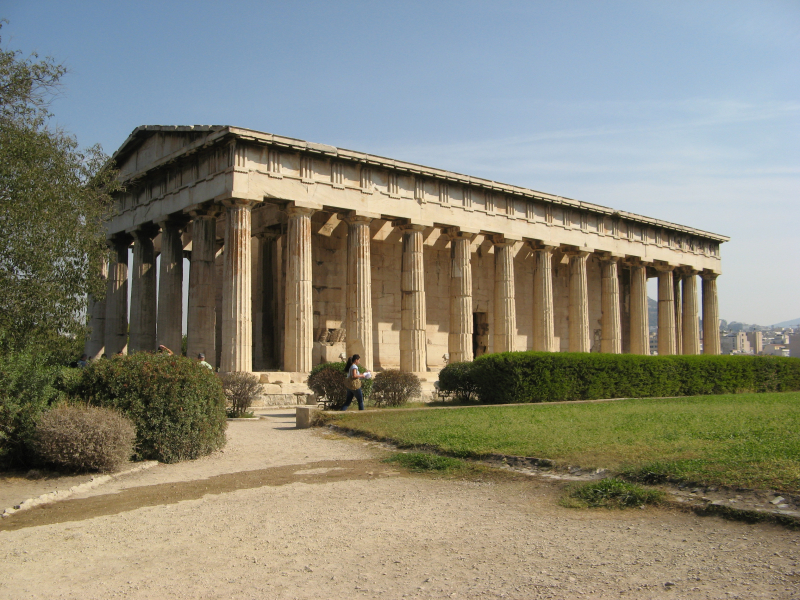
Source: Wikipedia Source: History Victorum -
Mycenae was once the capital of the Mycenaean civilisation and is now an important archaeological site in Greece. Mycenae was formerly one of Ancient Greece's most significant towns, and it is associated with several important works of literature, including the Odyssey and the Iliad. The Lion's Gate and the North Gate, which were formerly part of Mycenae's defensive walls and stood 18 meters high and 6 to 8 meters thick, are among the well-preserved sites today. The walls, which are built of massive limestone stones, are typical of the Cyclopean masonry utilized by the Mycenaeans to build their wall circuits. Another example might be seen in Tiryns, a neighboring town.
In 1999, Mycenae and Tiryns, an adjacent site, were designated as UNESCO World Heritage Sites. Tiryns and Mycenae are good places to visit in order because of their shared history. The National Archaeological Museum in Athens houses many of the most famous Mycenae finds, including the golden face mask of 'Agamemnon.'
Location: Mycenae
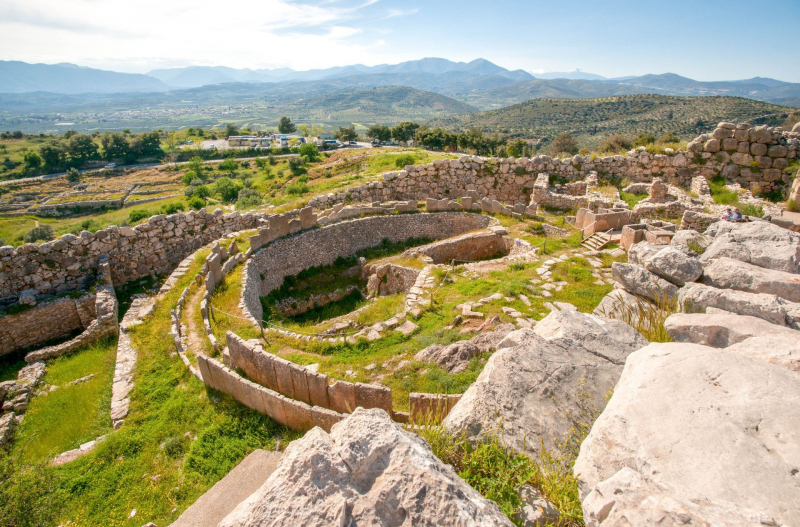
Source: Greeka Source: History Victorum -
The Knights Hospitaller of St John resided in the Grandmasters Palace of Rhodes. The Grandmasters Palace, which dates from the fourteenth century (about 1309), served as the headquarters of this prominent Christian and military order until Rhodes was seized by the Ottomans in 1522. This is one of the most beautiful historical sites in Greece.
The palace was repaired by the Italians who inhabited the Dodecanese islands at the time, during the turn of the twentieth century. During the 1930s, considerable repair work was completed. It was used as a vacation home for King Victor Emmanuel III of Italy and Benito Mussolini in the years that followed.
The Grandmasters Palace now functions as a museum and exhibition space. Two permanent displays of the ancient and medieval city of Rhodes are located on the ground floor, while the reconstructed majestic rooms of the Palace, as well as the outstanding floor mosaics, are located on the upper floor. The mosaics date from the late Hellenistic period and were originally from Kos before being brought to the site during the Italian restoration.
Location: Rhodes
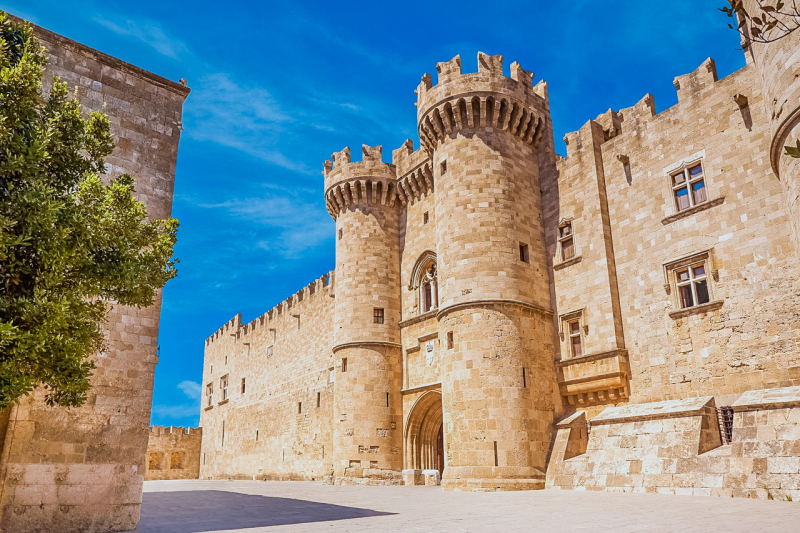
Source: rhodos.gr Source: Tourism Rhodes -
Meteora is a spectacular collection of monasteries built high atop Greek mountains in a stunning natural setting. "Meteora" roughly translates as "suspended in the air." Meteora is a magnificent network of massive black stone pillars rising outside Trikala, near the Pindos Mountains. After Mount Athos in Halkidiki, the monasteries that perch atop these cliffs are Greece's second most prominent monastic community. Only six of the thirty monasteries that were founded over the centuries are still operational today.
The Holy Monastery of Great Meteoron, erected in the mid-14th century and now a museum, is possibly the most notable of the Meteora monasteries. Agias Triados, Agiou Nikolaou, Varlaam, Agias Varvaras Rousanou, and Agiou Stefanou.
Each of the monasteries charges a nominal fee to enter. Men and women are expected to wear clothes that cover them in general when visiting Meteora. The monasteries themselves are full of holy artifacts, wall paintings, icons, and libraries full of antique manuscripts, in addition to affording a wonderful perspective.
Location: Thessaly
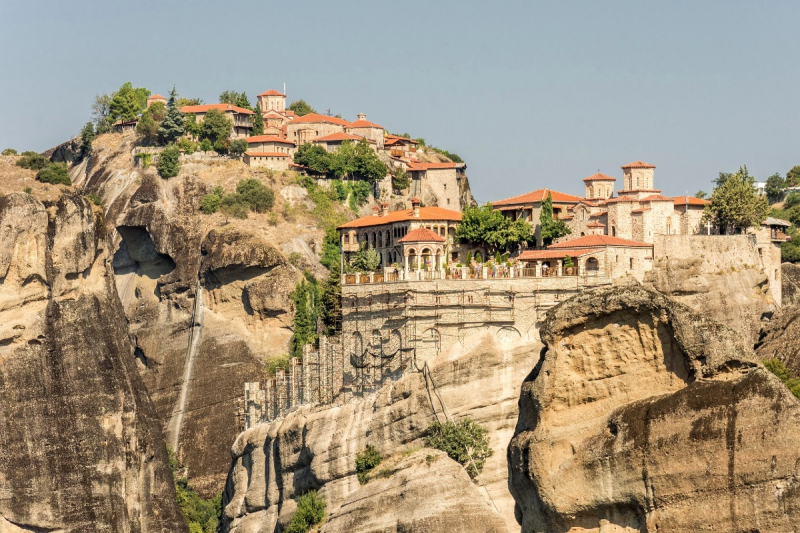
Source: Real Greek Experiences Source: Brett Conti -
Delphi is a well-preserved archaeological site on mainland Greece that contains the remnants of one of antiquity's most important communities. The 'bellybutton of the ancient world', as it is known. Many of the sites in Delphi date from the 5th century BC, but the Romans repaired and changed many of them. Many of the structures were also damaged or destroyed as a result of fires and earthquakes. Walking through Delphi, however, provides an interesting glimpse into the lives of the city's past residents.
Delphi - one of the most beautiful historical sites in Greece, was classified as a UNESCO World Heritage Site. It is still one of Greece's most famous tourist destinations, nestled in the gorgeous Pleistos Valley. As the path zigzags up the side of Mount Parnassus, leading visitors past a variety of stunning remains, visitors can experience firsthand the ancient settlement's almost "multi-layered” character. From the Temple of Apollo to the mountaintop stadium, there's a lot to see.
Location: Phocis
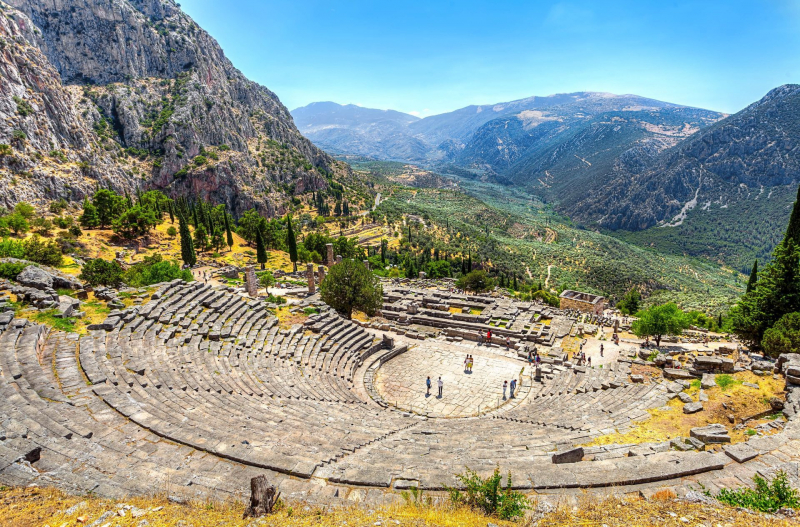
Source: Greeka Source: Rick Steves' Europe -
Knossos, pronounced 'ko-no-so,' was a significant ancient site on the outskirts of modern-day Heraklion, Crete. Knossos is thought to have been initially settled in Neolithic times, circa 7000 BC, and then inhabited continuously until the reign of the Ancient Romans. In addition, the location is one of our top 10 Greek tourist destinations. The Minoan civilisation's capital, Knossos, reached its pinnacle during the 19th and 14th centuries BC. The majority of its amazing buildings, the remnants of which may still be seen today, were built during this period, however it was destroyed on a huge scale probably between 1500 and 450 BC.
The Knossos Palace, commonly known as the Labyrinth because of its amazing maze of corridors and apartments, is the most famous of these today. An hour and a half is spent on a guided tour. The Palace of Knossos is made up of many rooms, including banqueting halls, religious shrines, and even a throne room, all of which are centered around a courtyard. Knossos' drainage system is particularly remarkable in and of itself, demonstrating a high level of expertise.
Location: Crete
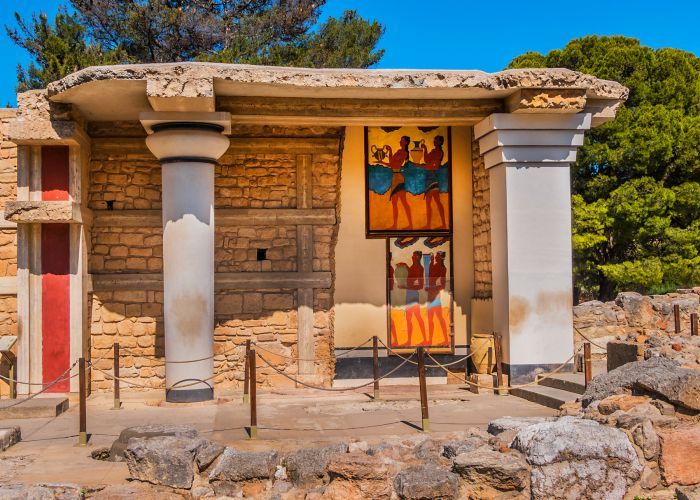
Source: Greeking.com Source: Le Monde en Vidéo -
Olympia was a bustling Ancient Greek metropolis. Olympia was inhabited as early as 3000 BC, but it wasn't until after the fall of the Mycenaean civilization that the city began to grow, and by 900 BC, it was already considered a significant sacred place. The city began to flourish and grow throughout time. The Treasuries and the Temple of Hera, both religiously significant and contained in the sacred precinct known as the Altis, and the Pelopion, the purported tomb of the mythical Pelops, are examples of the result of this steady evolution. Around 600 BC, these were constructed.
Olympia is well-marked, making it simple to tour the site and imagine how it could have seemed in its glory days. The Olympia Archaeological Museum is a good place to go if you want to learn more about Olympia. This is one of the most beautiful historical sites in Greece.
The old stadium is a must-see site, with many visitors still putting their speed to the test in running races. During the 2004 Olympic Games, the shot put competition was contested here.
Location: Peloponnese
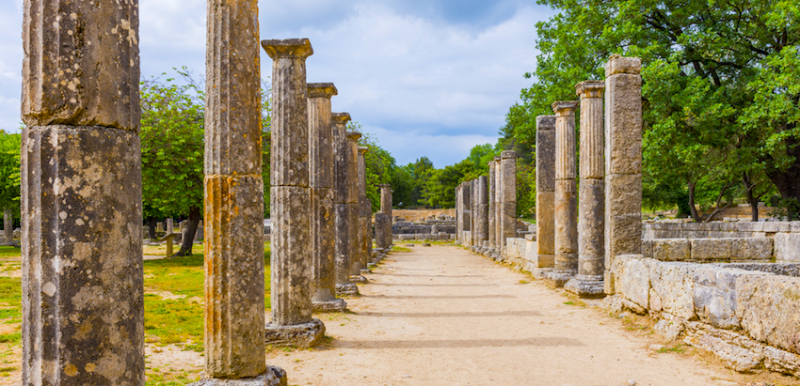
Source: Greecetravel.com Source: Run The Atlas































